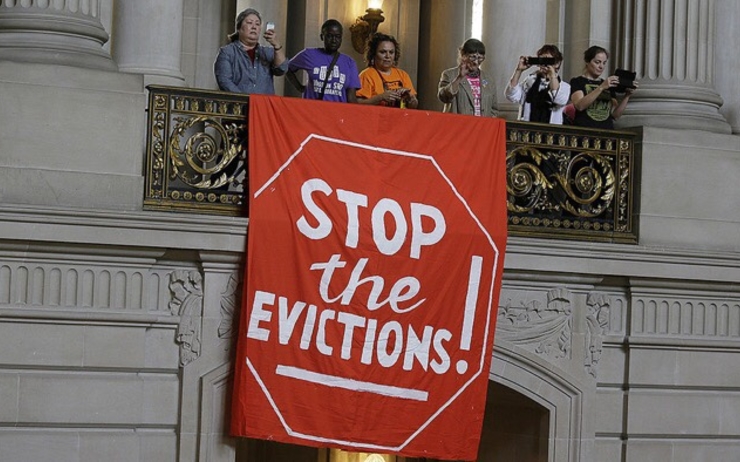In New York State, no winter break! Housing eviction orders ordered by judges apply from January to December. In 2018, just over 19,000 New York tenants were evicted from their homes. In the land of king money, no compassion with the most vulnerable, even if New York City has put several measures in place to defend them as well as possible.
Over 230,000 eviction requests
They are fifty judges, hired for a period of five years, to arbitrate every day in the six courts of “Housing” which counts the city of New York. With an annual salary of 135,000 dollars, they see New Yorkers parade every day facing complicated financial situations. 95% of cases dealt with in New York Housing Courts relate to unpaid rents. The remaining 5% concern owners wishing to get rid of a harmful tenant, but also tenants suing their landlord for breach of their obligations.
In the event of unpaid bills, the eviction request procedure is initiated by the owner, or the “management” of the building, at the third deadline. Some are more virulent and start the process from the second unpaid. Others, more tolerant, will wait several months.
In 2018, out of the 230,071 exclusion request files filed with the various New York courts, just over 19,000 files were brought to the end of the procedure, namely the eviction of tenants, supervised by a marshal. .
According to figures provided by New York City Council, the Bronx borough sadly sits at the top of the table with 6,858 evictions in 2018, or 34% of all evictions carried out in New York City last year. In Brooklyn that same year, 5,701 people lost their homes, 4,043 in Queens, 2,709 in Manhattan and 659 in Staten Island.
A dive in court
We enter Manhattan Housing Court as we enter a mill. No need for a summons. Once past the metal detector and a cursory search of the bag, we walk into another world, that of the “deportables”. In the corridors of the court, men and women, but also children in strollers or clinging to their mother’s hand. Elderly people are clinging to their walker. As for tenants missing the paid rent, we see a majority of women, overwhelmingly African-American or Hispanic. They, as well as the men present, face justice and risk losing their homes. Opposite, quite aggressive lawyers, mandated to at best recover the unpaid debts, at worst to evict the “bad tenants”. Between the two, the judges arbitrate the cases, decide but also reassure and sometimes even defend. While others sink. A lawyer will explain to us that the judges, despite their supposed impartiality, are either “pro tenant” or “pro landlord”. In one of the courtrooms, we will even hear a judge throwing at a tenant on the verge of tears “green is the king”, green obviously representing the American banknote. Sad America!
An eviction procedure can last up to six months, or even more for a well-defended tenant. But now, those who can not honor their rent can hardly hire a lawyer to represent them. Also, the city of New York takes care of the defense of the most fragile, since the annual income of the household does not exceed 25,000 dollars per year. Or two months’ salary for a judge. For those with less limited resources, free consultation with a lawyer is possible, without the latter coming to defend at the bar. Likewise, tenants in certain postal codes – where poverty is greatest – may benefit from special assistance. Finally, according to a clever calculation relating to the debt accumulated by the tenant and his income, the city of New York can also settle the unpaid debt to the owner and set up an interest-free repayment schedule with the tenant, miraculously out of its trouble with the law. However, from our observations, we found that more than 75% of the tenants concerned were not represented by a lawyer. Likewise, not all were able to express themselves in correct English. As such, the course offers translation assistance in all the languages spoken in the city. But is it enough?
The virtuous circle of expulsion
American sociologist Matthew Desmond has examined the subject of the cruel mechanics of eviction in his book “Evicted. Poverty and Profit in the American City ”, which won him the 2017 Pulitzer Prize. Desmond explains the devastating effects that eviction has on a family, usually a single parent. Wandering from reception facilities to more than precarious housing, children find themselves not only without landmarks, since they are forced to change schools and lose their friends, but also live in fear and are exposed to the violence of the shelters. . Likewise, for parents, changing address so often also makes it very difficult to obtain meager housing assistance. Not to mention the time spent finding new accommodation which compromises the chances of keeping your job. Finally, the “expelled” also become targets because they represent a real economy. Some owners of substandard housing don’t hesitate to rent slums at shameful rents in exchange for a relatively poor rental record. The eviction “market” is profitable both for these unscrupulous landlords, for the lawyers of the “Housing Courts” and for the marshals.
Commercial leases are also affected
Individuals are not the only ones affected by eviction procedures. Indeed, commercial leases, whether they relate to an office or a business, can also be the subject of such a procedure. Between January 2017 and today, some 4,000 business evictions have been made in New York City. While it is in the Bronx that there are the most, with a ratio of 3.5 evictions per 100 commercial leases, it is the postal code 10001, or Midtown, which is the most affected in Manhattan. This is hardly surprising considering that it is the New York neighborhood that has the most commercial leases.
After an eviction, and before his furniture and personal effects are thrown into the street, a tenant still has the possibility of finding his apartment, for this, he has one month to settle his debt to his owner, in addition to the lawyer fees of the latter and 1,500 dollars in fees applied by the marshal. Otherwise, the most disadvantaged will be accommodated in “shelters” in the city, the most isolated will find themselves on the street. This is America too!
–


